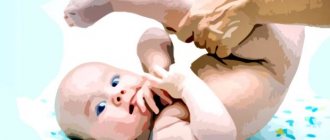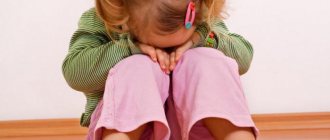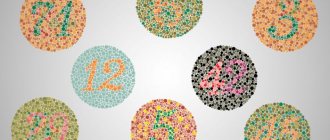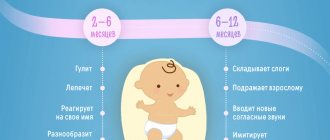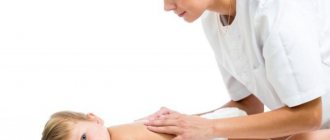Advertisement
Massage for a child is not only affection, but also communication, which will allow the mother to establish a closer relationship with the baby. This therapeutic procedure helps the baby in development and is suitable for both the prevention of diseases and their treatment. Massage helps in setting up the coordinated functioning of the organs and systems of the body.
Massage has a beneficial effect on the development of the child’s nervous and musculoskeletal systems. Spending 15 minutes once a day. With this useful procedure, you will ensure the harmonious development of the baby and stimulate knowledge of the world around you. Communication during massage is mandatory; it stimulates speech development. It is better to do a massage in the daytime, an hour after the second breakfast or lunch, the child should not be hungry. If the baby is not in the mood, you can skip the procedure.
When you start the massage, your hands should be warm, your nails should be cut short, you should remove rings, watches and bracelets so as not to injure the baby’s delicate skin. First, establish contact with the baby, talk to him, and then start the session. Perform all techniques carefully, without sudden movements or jolts; if rashes of an allergic nature are visible on the skin, avoid these places. Analyze your child’s behavior, highlighting the techniques that he likes so that you can start the next sessions with them.
Advertisement
Is massage beneficial for all children - both healthy and sick?
This is true - ask any doctor, and he will confirm it.
But if everything is clear with those children who have any problems, then why do healthy kids need a massage?
According to many years of observations, healthy children who were constantly given a restorative health massage (even by the parents themselves, and not by specialists), develop much faster than their peers.
It is massage for children under 1 year of age that becomes the powerful foundation on which the child’s full and comprehensive development occurs.
This is one of the most accessible healing methods, which is literally in the hands of any mother or father, since such a procedure does not require the help of a professional massage therapist. It’s enough just to follow simple recommendations and rules, and your warm, caring hands will help your baby grow up strong and healthy!
Gymnastics for a 1 year old child
Before starting classes with your child, the room must be ventilated for 15 minutes. Gymnastics and massage begin either an hour and a half after a meal, or before a meal, but no less than 30 minutes.
It is advisable to do gymnastics in the morning. You can involve other children and all family members in activities with your baby. Gymnastics should take place in a playful way, and should begin and end with the child’s favorite exercises. Each exercise should be repeated 5-7 times, new ones - 2-3 times. During gymnastics, you need to work out all muscle groups. The set of classes includes the same exercises as a month earlier. You can add walking on a narrow path, to prevent flat feet - on a ribbed surface, raising straight legs from a lying position to a right angle, raising the body from a lying position, alternately raising arms, throwing a ball with both hands, walking behind a gurney, getting objects from a height, lifting head and body parts lying on the back, arching the body, crawling under objects, somersaults. Regular walks, swimming, and, if possible, a swimming pool, hardening, and air baths should also be included in the complex of health-improving activities.
Types of massage for babies up to 1 year
There are only three types of massage for children, as well as for adults: preventive, corrective and therapeutic. If no disturbances or pathologies are observed in the development of your child, then from one and a half to two months you can begin to do preventive massage yourself.
If any developmental abnormalities or diseases are detected in the baby, he is prescribed a corrective or therapeutic type of massage. Such sessions are prescribed by a doctor, and they should also be conducted by a specialist. However, if you do not have the opportunity to find such a professional massage therapist or pay for his work, you can attend several sessions and ask the master to show you the techniques of such a massage, and then do it yourself at home.
General rules and recommendations
Massage for a 4 month old baby
There is a general set of rules and tips on how to massage babies up to one year old:
- The main condition is the baby’s readiness. If the baby is capricious or restless, it is better to refuse the procedure.
- When a baby is sick, you cannot put additional stress on his body. An exception is massage to improve expectoration of mucus, against nasal swelling, and for colic. After vaccination, you need to wait 5 to 7 days for the procedure. Skin irritation is also a reason for transfer.
- The temperature in the room should be quite high - about 26 degrees. There should be no electrical appliances, bright lights, or heating devices near the massage site. Drafts should also be avoided.
Baby massage at home
- The massage is carried out an hour after eating. Food must be digested.
- The parent's hands should be warm, without long nails, hangnails, or jewelry (so that the procedure is comfortable for the child). Be sure to use cream or special massage oil.
- During the massage, the child should be naked and lie on a diaper (preferably a disposable absorbent one).
For what diseases is massage indicated?
With the help of corrective and therapeutic types of children's massage, our medicine successfully copes with such childhood diseases as scoliosis, hip dysplasia, flat feet, congenital clubfoot, torticollis and other pathologies of the musculoskeletal system.
Respiratory diseases such as bronchitis, rhinitis, pleurisy, bronchial asthma are also indications for massage. Massage is also prescribed for many diseases of the gastrointestinal tract and central nervous system, as well as rickets, hernia, and various disorders of muscle tone.
If your child has been diagnosed with one of these diagnoses, be sure to find an opportunity to arrange a visit to therapeutic massage sessions to get rid of this disease.
NEW LEVEL
The article was written for the magazine “My Child”
“The mother began to wash the newborn. She washed Bambi with her tongue, carefully and diligently, hair by hair, licking her son's skin. And this gentle work had everything: a bath, a warming massage, and affection.”
This incredibly touching scene, with which the book about the deer Bambi begins, is invariably repeated in all mammals at the birth of babies. Why, at a certain stage of evolution, human mothers stopped licking their babies is now unknown. But newborn babies still have not lost the acute innate need for frequent stroking and caressing touches, characteristic of babies of all other species. Modern research is helping us understand why this almost completely lost element of care is extremely important.
Physiologists believe that the mechanical side of the effects of massage is just a small tip of the iceberg: most importantly, massage has a powerful effect on the central and autonomic nervous system, and from there positive signals are transmitted to all organs and cells of the body. To put the same thing in simpler words, by massaging your child, you send the message that he is loved and protected to all the most remote corners of his body.
Massage is as integral a part of caring for your baby as feeding, rocking or changing wet diapers. For a baby, this is the first way of communication and the first language of communication. He learns what respectful affectionate touch is and learns to love and accept his body. And a young mother feels much happier and more confident in her relationship with her baby if immediately after giving birth, even before the first breastfeeding, she was allowed to properly feel and stroke the newborn’s body from crown to toes. These actions undoubtedly represent a certain type of massage. In the future, frequent hugs and stroking help to establish a close biological connection with the child, which significantly facilitates maternal work.
Therefore, it is hardly worth considering daily baby massage as a general restorative medical procedure. The massage that will be discussed here has little in common with the treatment course that, if necessary, is carried out in the clinic by a specially trained foreign aunt.
Strange as it may seem at first glance, a mother who performs a simple, regular home massage receives almost more benefits and pleasure from it than her baby. Every day, as her hands gently and rhythmically glide over the baby's skin, she begins to gain more confidence, experiences deeper affection, and better understands the needs of her child. Massage reduces the level of stress hormones not only in the baby’s blood, but also at the same time in the blood of the mother who massages him, and this prevents her from developing postpartum depression.
Problems such as too frequent chaotic breast demand go away. The number of applications is quickly approaching the age-related physiological norm. Feeding on demand becomes truly feeding on demand, and not an endless, exhausting hanging on mom's chest in an attempt to overcome stress.
On the other hand, many mothers who constantly massage their babies, having interrupted the massage for one reason or another for several weeks, noticed significant negative changes in the behavior of their children. Restlessness and irritability appeared, sleep became worse.
Where to begin
You need to start with the idea that anyone can easily cope with a massage. Petting your baby is simple and natural. No special skills or talent are needed, and no prior training is required. On the contrary, by practicing massage, you learn to touch children confidently and deftly.
With the smallest children it is better to use the simplest touches. Stroke and feel the baby. All your movements should be very slow and caressing. At first, do not try to imitate a professional masseuse, whose hands confidently flutter over the client. Place your hands on the baby, feel how warmth and love are transmitted through your hands to the child, let the baby feel your goodwill.
Let's get comfortable
Of course, you can place the baby on the changing table as they do in a children's clinic. You can also sit in a more democratic position. To do this, we sit down with our legs crossed in Turkish style and move the lying baby close to us.
But the experience of peoples who traditionally practice baby massage offers us something more pleasant and natural.
Try to sit comfortably, leaning your back against, for example, a sofa cushion. Stretch your legs in front of you (it is better to wear shorts), place the child on your closed legs, bend your knees slightly and pull them towards you. The baby lies face to face with his mother, the bottom of the back is warmed by the mother’s warm feet, and skin-to-skin contact is then more complete and natural. In this position we massage the legs, stomach, arms.
We massage the back by placing the baby on your chest (minimum clothing), vertically, facing the mother. It turns out that your hands alternately stroke the baby and then hug him.
In essence, a massage is pampering and fun for both of you. So the more relaxed and casual the position in which you sit, the better.
It is believed that it is useful to accompany massage with nursery rhymes and songs. But many mothers feel the stress of having to continuously recite awkward, poorly memorized rhymes out loud with expression. Do what pleases you best. If, while working with your child, you hum songs with pleasure or say something affectionately, and you feel that the atmosphere becomes soft and soothing from this, then do just that. If you feel awkward, perceive it as an additional burden, then it is better to silently smile at the baby and continue the massage in silence. You will definitely chat with the baby a little later, but for now just communicate with him using affectionate touches.
Let's choose oil for massage.
Hands should glide easily over the baby's skin, without bunching it up or irritating it. Therefore, it would be good to massage not “dry”, but using moisturizing oil.
Children's massage oil from well-known manufacturers should be used if, after carefully reading the composition on the label, you do not want to regularly rub the complex chemical compounds listed there into your baby's skin.
Parents who prefer something more natural are more likely to choose cold-pressed edible vegetable oils. This could be olive oil, grape seed oil, avocado oil. A rather expensive but absolutely luxurious option for baby skin is almond oil or apricot kernel oil. You can find these oils in large supermarkets or ask spice traders at the market.
Interestingly, in India, where the ancient tradition of massaging their children has never been interrupted, mothers use different oils depending on the season. In hot weather they prefer light and cool coconut oil; in winter they usually switch to mustard oil, which retains heat. You can conjure up the composition of massage oil not only depending on the weather, but also in connection with the behavior of the baby. For babies who have anxiety at the breast, a drop of orange oil would be an excellent addition, and for troubled sleep - lavender. And three drops of lemon oil added to a bottle of massage oil will help you more successfully resist viruses during the winter flu season.
You should apply the oil not to the child, but to your palms. Drop in and then lightly rub and warm the oil in your hands.
It is best to start massaging the baby from the legs and feet. Judging by the reaction, the baby feels these parts of the body as the least vulnerable. If you observe a newborn, you will see that it is with the help of his feet that he prefers to make tactile contact with the world. The arms are still clenched into fists and pressed to the body.
First, ask your baby for permission to start the massage, greet him with a warm, affectionate touch. Take his legs in your palms, let the child feel the weight of his mother’s relaxed hands and their warmth. Imagine how your tenderness and care, passing through your hands, dissolves in the baby’s body.
We massage the foot in the direction from the heel to the toes.
“Trample” your fingertips along the baby’s sole, using light but firm pressure.
Then iron each finger separately.
Use your fingertips to massage the indentations above your heel, behind your ankle.
Using your thumbs, massage the outside of your foot toward your shin.
Smoothly stroke the shin in the direction of the knee.
Thigh - from the knee to the buttock, almost not covering the inner surface of the thigh. Roll the leg in your palms, as if you were rolling a sausage out of plasticine. For some reason, children usually find this useful technique amusing.
In a unifying motion, move your palms from your buttocks to your feet and back. This gesture will let the child know that you are moving on to massage another part of the body.
Calmly place your hands on your baby's tummy and watch his reaction for a few seconds, as if asking permission to move on. Sometimes it is psychologically difficult for children to “open” their tummy and chest for manipulation. Respect the right of even such a small person to be the master of his body. We interpret any defensive movements of the hands (crossing, palm raised in protest) as a decisive refusal. Hug your child, reassure him and try again a little later.
If the baby is in a favorable mood, begin circular movements with your palms around the navel, clockwise.
We massage the breast using a technique similar to smoothing the pages of a book. We move the entire surface of the palms from the center to the periphery, from the diaphragm to the shoulders.
The youngest children sometimes agree reluctantly to a hand massage. When you see the arms bent and pressed tightly to the chest, do not insist, just stroke them from above gently and carefully. Next time the baby will feel more relaxed and will condescend to let mom massage her precious palms.
Using your index finger and pressing, draw rings around the center of your palm. Here is the point responsible for well-being in the intestines. (So Soroka-Soroka is not a game at all, but an effective way to get rid of stomach pain).
Raise your child's hand up and stroke the armpit from top to bottom. These babies are not yet afraid of tickling, but large lymph nodes are located in these places.
Hold the child's wrist with one hand, and the other, stroking evenly, moves from the wrist to the shoulder.
Massage your wrist in a circular motion.
Massage each finger separately.
Roll the pen between your palms.
Use wide, caressing movements of your palms from the head to the feet and back.
Start smoothing your face from the middle of the forehead. Try not to cover your baby's eyes with your hands so that he can continuously see your face.
Gently move your fingertips from the bridge of your nose to your temples. There is no need to make reverse movements.
Using your thumbs, draw a smile, first above the child’s upper and then below the lower lip. Smile with him.
There are not many massage techniques described here, and you should not set out to learn and apply as many of them as possible. Even after learning a lot of different movements, you will most likely settle on the minimum number of the most convenient for you and the most enjoyable for your baby. A successful massage does not lie in using many different techniques and movements in one session, but in the ability to intuitively select the most effective ones. Listen to your intuition, because the body is almost never wrong. If you and your baby especially enjoy doing something, then this type of influence is now bringing maximum benefit.
The simplest example: a baby will really like stroking movements when he is cheerful and calm, but they will most likely irritate a crying baby even more. But a measured pat on the back with your palm quickly calms a frightened or upset screaming child. Probably, over nine months he has become accustomed to associating even tremors with a frequency of about 60 beats per minute with peace and well-being (the pulse is normal, which means nothing threatens my mother and me). This massage technique is so effective in calming the baby that for some mothers it becomes an automatic habit, something like rocking.
Other massage movements can become just as mechanical, migrating from the daily routine into your and your baby’s daily life. You will have to remind yourself that it would be nice to once again “lick” the baby a little with your hands. Then you will automatically make stroking movements at every opportunity. A few circular movements on the tummy while changing a diaper, rubbing a stiff back after sleep, stroking your forehead and ear with your fingers while breastfeeding - gradually your hands will begin to do all this as if independently of you.
Author Tatyana Kondrashova, photos of Olga Ermolaeva were used in the design of the article
If you liked this article and want to learn more about ways to gently care for your baby, helping to relieve stress and promote breastfeeding - such as adaptive bathing, free swaddling, disembarkation - we invite you to watch the recording of Tatyana Kondrashova’s webinar, where she talks about everything in as much detail as possible with step-by-step instructions!
Go to other interesting articles on breastfeeding for mothers
Our useful and interesting webinars for nursing mothers
Some advice for parents who want to learn massage techniques
The massage therapist’s hands are his only instrument; they must always be clean and warm.
Before the massage, prepare your baby’s favorite cosmetic oil or baby cream - let the familiar pleasant smell immediately put him in a positive mood.
The best time for a massage is the time between two feedings, perhaps in the late afternoon or after bathing - massage helps you fall asleep quickly and soundly. And you must also remember that touch is the same means of communication with the baby as the word.
The first session should be short, no more than 4-5 minutes. In the future, you can add 2-3 minutes daily, bringing the duration of the massage session to 25-30 minutes.
Monitor your child’s mood, talk to him, tell him what you are doing at the moment. If your baby doesn’t like the procedure, is fussy or cries, think about what you’re doing wrong. If everything happens correctly, taking into account all the recommendations, then sooner or later the massage should begin to bring pleasure to the child.
Massage for children from 2 weeks
You can start doing a light massage when your baby is 2-3 weeks old, stroking the legs, arms, back, tummy from the periphery to the baby, lightly stretching the fingers and toes. A 5-10 minute session at this age is quite enough. You cannot use force, put pressure, or force a massage; if the baby is capricious , the massage time must be reduced. Get used to touching; there are many nerve endings on the feet and palms, on the fingers and toes; by stimulating them, you contribute to the development of hearing, vision, and speech processes.
Stroking the tummy clockwise promotes better absorption of food. Sometimes it is enough to put your hand on the baby’s tummy to warm him up, and the baby will feel better during an attack of colic . When massaging, do not touch the spine, lymph nodes under the knees and armpits, liver and heart areas.
Massage for the little ones
In children's massage, almost all massage techniques for adults are used, but they need to be performed gently and gently. A massage should be a pleasure for the baby, and not just a therapeutic procedure. There are baby massage techniques such as stroking, superficial and deep kneading, rubbing, vibration, and light patting.
- Stroking
- rhythmically make light sliding movements over the baby's skin with your palms or the back of your hands. This technique improves metabolism and has a calming effect; - Rubbing
is the same as stroking, only with stronger hand pressure. Has a positive effect on the skin of the body, subcutaneous fat and muscles located directly under the skin; - Kneading
- done with sharper and shorter movements, with more pressure than when rubbing. Kneading has a beneficial effect on deep-lying muscles. At the same time, their nutrition improves, blood supply increases, strength, mass, and contractility increase. - Tapping or patting
- first with one, then two, three and four fingers of both hands (their back) make a series of rhythmic blows on the baby's skin. This method of massage is especially useful for overweight children; - Vibration
- this technique is rarely used for children under the age of 1 year. At the same time, movements are made that cause a slight rhythmic shaking of the whole body.
Children under one year old especially love stroking. Start and end each session with it. And let your kids grow up strong!
Massage for children from 6 to 12 months
Massage for children over the age of six months includes techniques such as bringing the arms together on the chest, bending the legs (alternately and simultaneously); rollovers from back to stomach; alternating stroking, rubbing, sawing, kneading, tapping and pinching the back; bending the legs while lying on the stomach with emphasis on the palms or the wall; stroking and rubbing the tummy; raising straight legs; squats with hand support; rollovers from back to stomach.
Let's get comfortable
Of course, you can place the baby on the changing table as they do in a children's clinic. You can also sit in a more democratic position. To do this, we sit down with our legs crossed in Turkish style and move the lying baby close to us.
But the experience of peoples who traditionally practice baby massage offers us something more pleasant and natural.
Try to sit comfortably, leaning your back against, for example, a sofa cushion. Stretch your legs in front of you (it is better to wear shorts), place the child on your closed legs, bend your knees slightly and pull them towards you. The baby lies face to face with his mother, the bottom of the back is warmed by the mother’s warm feet, and skin-to-skin contact is then more complete and natural. In this position we massage the legs, stomach, arms.
We massage the back by placing the baby on your chest (minimum clothing), vertically, facing the mother. It turns out that your hands alternately stroke the baby and then hug him.
In essence, a massage is pampering and fun for both of you. So the more relaxed and casual the position in which you sit, the better.
It is believed that it is useful to accompany massage with nursery rhymes and songs. But many mothers feel the stress of having to continuously recite awkward, poorly memorized rhymes out loud with expression. Do what pleases you best. If, while working with your child, you hum songs with pleasure or say something affectionately, and you feel that the atmosphere becomes soft and soothing from this, then do just that. If you feel awkward, perceive it as an additional burden, then it is better to silently smile at the baby and continue the massage in silence. You will definitely chat with the baby a little later, but for now just communicate with him using affectionate touches.
How to choose a children's massage therapist for massage at home?
Natalya Viktorovna is a professional for whom children's massage is not a job, but a vocation.
Natalya has been exclusively engaged in children's massage for more than 12(!) years. Mothers often ask questions about how to choose a massage therapist for their child. After all, a baby up to one year old cannot say whether he likes the procedure, and the mother cannot immediately assess its effectiveness. Other people's good reviews do not always guarantee that this particular specialist will be ideal for your child, but they help you get your bearings. What should you pay attention to when meeting? Appearance, neatness, friendliness are the calling card of a massage therapist. Changing your shoes, putting on a robe and washing your hands is the responsibility of a specialist who comes to a house where there is a baby. And during epidemics, it is better to wear a mask.
A good children's massage therapist will definitely ask for the opinions of a neurologist, orthopedist and pediatrician, specify the most convenient time for the procedure, tell you how the massage will take place, what manipulations are performed and why.
The education of a specialist who massages children must be at least secondary medical education. A diploma and specialist certificate is required.
The first meeting and the first procedure can be stressful, especially for children from 8-9 months to one and a half years, but a good massage therapist will try to find contact with the baby.
The effect of the massage becomes noticeable after 5-7 sessions, but for the results to be sustainable, at least 8, and preferably 10-12, sessions must take place. Most often, massage for children is performed according to the scheme: 5 days work, 2 days rest. After all, a child’s body also needs rest! In cases of working with premature, weakened or low-weight babies, massage can be performed every other day. It is very good when the time is immediately assigned to the patient - it is convenient for both mother and baby.
Where to begin
You need to start with the idea that anyone can easily cope with a massage. Petting your baby is simple and natural. No special skills or talent are needed, and no prior training is required. On the contrary, by practicing massage, you learn to touch children confidently and deftly.
With the smallest children it is better to use the simplest touches. Stroke and feel the baby. All your movements should be very slow and caressing. At first, do not try to imitate a professional masseuse, whose hands confidently flutter over the client. Place your hands on the baby, feel how warmth and love are transmitted through your hands to the child, let the baby feel your goodwill.


